The first images beamed back from the James Webb Space Telescope (JWST) were filled with jewels and fire. That’s what the galaxies look like, tiny and distant, resplendent in false-colour contrast: red, gold, and white-blue. Some stretched like gummy candies from gravitational lensing. Some radiated a six-point star, the signature artefact of JWST’s hexagonal mirrors. In one image, four large galaxies held for a breath in their cosmic dance, a moment in a long gravitational embrace that will end with their eventual merging. Under JWST’s gaze, the rusty crags of the Carina Nebula were translucent to the countless stars being born within. In the telescope’s infrared vision, dust is transparent. Nascent stars were unveiled; the most distant galaxies ever seen, recorded

The JWST image of the interacting galaxies known as the ‘Stephan’s Quintet’ group. Courtesy NASA, ESA, CSA and STScI
These images were chosen to impress: a stellar nursery, a galactic dance, the Universe’s first aeons, the death shroud of an exploded star. The fifth image is a graph of a wiggly blue line, studded with white data points. Four peaks of the blue wiggle are labelled ‘Water H2O’, marking the wavelengths of light absorbed by water molecules in an atmosphere. It is an image so unremarkable that NASA presented it over an artist’s impression of an exoplanet and star. Writing in The New York Times in July 2022, Joshua Sokol described the secretive process behind selecting these first images, full of visual splendour and scientific promise – the ‘early highlight reel’ that would, as the US president Joe Biden put it, ‘remind the world that America can do big things’. But it was that plain graph I was most excited to see. Not because it was beautiful, but because of what it meant: it was the portrait of an atmosphere of a planet 1,120 light years away. The first of many to come. I didn’t care about this particular gas giant. But I knew that other planets JWST could ‘see’ might be possible homes to life.

Composition of the atmosphere of exoplanet WASP-96b. Courtesy NASA, ESA, CSA, and STScI
For centuries, we’ve seemed to be on the verge of finding life beyond Earth – from Galileo’s first observations of Venus through a telescope and his realisation that planets were other worlds, to Percival Lowell’s observations of ‘canals’ on Mars, to the hopes of every NASA rover and SETI search. Yet the more we’ve learned about the solar system, especially in the past century, the rarer life has started to seem to be. Mars has no vegetation, let alone canals. Venus’s clouds don’t shroud a humid jungle but a surface so greenhouse-hot it can melt lead. There are thin hopes of finding traces of life from Mars’s warmer, wetter past. A slim chance that the subsurface oceans of outer-solar system moons might teem with exotic microbes. But there are only eight planets in our solar system. With the discovery of the first planets orbiting other stars in the 1990s, hopes for abundance re-emerged: so far, we’ve found more than 5,000 exoplanets, and scientists now believe that, if you point to any star in the sky, odds are a planet circles it. All those possible homes for life, and that’s just in our galaxy. Zoom out to JWST’s deep field, the galaxies scattered like jewels on black velvet – each comprises hundreds of billions of stars, and perhaps hundreds of billions of planets. They’re much too far away for us to ever know who or what might be living there but, as Carl Sagan liked to say, if there isn’t life out there, wouldn’t it be a waste of space?
We think we know how discovery might go, because we’ve been raised on so many versions of this story. Ellie Arroway in Sagan’s novel Contact (1985) catches a radio signal beeping prime numbers coming from the star Vega in which is encoded a message of welcome and the gift of shortcuts to technological advancement. In Michael Crichton’s The Andromeda Strain (1969), alien microbes hitch a ride to Earth on a satellite, wreaking havoc. In the movie Arrival (2016) – and a thousand other cinematic sagas of conquest or visitation – alien ships come to Earth. That one, at least, we can set aside as a likely model. But even when it’s a signal, even when it’s a microbe, we’ll likely never know if it’s aliens. Not just because of the vast distances involved or because of the wild possibilities presented by chemistry and biology, but because science seldom works that way. Discoveries almost never arrive as we think they will, as lightning bolt eurekas. They are slow, gradual, communal. Alien life may not be something we ever ‘find’, but instead inch towards, ever closer, like a curve approaching its asymptote. For all our desire to know who’s out there, that may have to be enough.
‘No single effect, experiment, or paper provides definitive evidence about its claims. Innovation identifies possibilities. Verification interrogates credibility. Progress depends on both.’ So opens the ‘Community Report from the Biosignatures Standards of Evidence Workshop’ (2022), quoting an earlier paper. The effects in question are not astrobiological: the quoted paper is from cancer research. But this is how all science works. Cumulatively, in small steps, on the shoulders of giants, and in fits and starts. It’s a process the public seldom sees. Nor does it match the story we’re usually told with its litany of heroes – Newton, Copernicus, Darwin, Einstein: men who saw beyond their era’s paradigm to glimpse a revolutionary new worldview, bringing it to humanity like Prometheus (but without the punitive price tag).
Our discomfort with the fallible process of science was made urgent during the COVID-19 pandemic. ‘Follow the science’ was a rallying cry, construing science as something other than it is; as a monolith rather than a process. When the stakes felt urgent, and personal, the slow sausage-making machine of science was not just unseemly, but a threat. Why was the best guidance changing? How could science not know! The search for life may be less urgent and less threatening, even if existentially higher-stakes, but we still think of scientists as plucking knowledge from the ether, finding truth and telling us. In reality, science isn’t about finding facts: it’s about creating knowledge.
A 2018 paper in the journal Astrobiology introduced a tool called ‘The Ladder of Life Detection’ that synthesises our understanding of life and our ways of detecting it into a framework for determining what combinations of evidence could be sufficient to ‘preclude any abiotic interpretation’; that is, to say not It is life but rather It couldn’t be anything else. The authors organised their criteria not by the potential to definitively prove life but ‘to convince a majority of the scientific community’. After all, life exists or it doesn’t – whether observed by humanity or not. What science changes is our collective knowledge. The threshold is consensus.
Astrobiologists are trying to answer one of humanity’s biggest questions with something like a shadow show
It seems like it should be simple. You have no trouble telling what’s alive from what’s not. A cat versus a rock, a tree versus water. You can recognise what might be called ‘technosignatures’ too, proof of intelligent life’s material manipulations: a car exhaust, a cell phone, a city grid. But astrobiologists say things like: ‘The detection of extraterrestrial life in our solar system and beyond will likely be neither instantaneous nor unambiguous.’ Or they write: ‘Evidence of life may be subtle or unfamiliar, and reveal itself only in stages, as one observing campaign informs the next.’ Aren’t they supposed to be smarter than us? They’re not exactly rocket scientists, but they’re in the department next door.
The problem is, you and I and the scientists are good at recognising Earth life. And big life, too. But scoop up a cup of seawater – or a slice of Antarctic ice – and it becomes much harder to determine what’s living. Even our intuition for habitable environments has been bested by microbial ingenuity, by extremophiles revealing the provinciality of our instincts. Then there’s viruses. Are they alive or not? You see how it gets tricky. Add to the mix trying to figure out all this from afar: with a remote-control robot on Mars, or a snapshot of a spectral reading of an exoplanet’s atmosphere, and you see that astrobiologists are trying to answer one of humanity’s biggest questions with something like a shadow show.
Before we could read atmospheric spectra, all that could be known about an exoplanet was its mass, density, and how much energy it gets from its star. Plenty can be extrapolated from that: whether it’s rocky or gaseous, how much atmosphere it might hold, whether it might have liquid water on its surface. We know, generally, from how planets form, that the smaller ones are rocky and the bigger ones gaseous, like Jupiter and Saturn, while the smallest can’t hold onto an atmosphere at all. The same elements abound throughout the Universe, so distant planets are generally made of the same sorts of things as the worlds that orbit our Sun. So then what happens to all that geology and chemistry? Does some of it, as it did here, cross the ineffable line into life?
We can learn a great deal from a planet’s atmosphere. Earth’s oxygenated atmosphere, which makes so much of life possible, got that way only because of life, the advent of photosynthesis that uses carbon and starlight to make energy, giving off oxygen in the process. There’s water vapour, too, showing the planet is habitable and inhabited. The atmosphere also holds telltale evidence of technological activity, like chlorofluorocarbons. It’s a rich text to read if you have the technology to do so. But we don’t quite have that yet.
Nothing close to a confirmation of an alien biosphere will be coming from JWST
JWST, NASA’s most powerful space telescope, observes in the infrared spectrum – good for seeing through interstellar dust, but not for detecting some of the most important potential biosignatures, like water. The planetary scientist Maggie Thompson, at ETH Zurich, studies the viability of methane as a biosignature. ‘Methane,’ she told me, ‘is one of the best biosignatures we could be able to detect with something like JWST,’ but it’s hardly a best-case scenario. In fact, JWST wasn’t designed to look for biosignatures at all, the astrobiologist David Catling told me. Its instrument suite was decided when exoplanet discoveries had just begun to trickle in. Catling recalled giving a talk about how to find biosignatures with JWST, when a scientist who studies Earth’s atmosphere asked: Why aren’t you just looking for oxygen? Catling sighed to me as he related this. Oxygen’s spectral signature is in the range of visible light, which JWST can’t see.
An atmospheric biosignature is a hint of a hint of a hint, which we’ll likely never be able to confirm by direct sampling, given how far away exoplanets are. But the hints are nonetheless crucial. The astrobiologist Eddie Schwieterman told me: ‘Astrobiology is the study of the origin, evolution, distribution and future of life in the Universe.’ The solar system is just a tiny fraction of our own galaxy. And while the Copernican principle reminds us not to assume that we’re special, we can’t assume we’re average, either. For Thompson, an ideal scenario might be JWST detecting methane and CO2 in an exoplanet’s atmosphere. ‘If you saw something where there was a lot of methane, some decent amount of carbon dioxide, but very little or no carbon monoxide, that would be very interesting and worth exploring more.’ Still, the best you can hope for is to identify interesting targets for further study. Nothing close to a confirmation of an alien biosphere will be coming from JWST.
Every astronomer I asked about using JWST to look for biosignatures said something along the lines of The real good stuff will come from the Habitable Worlds Observatory. And when will that come online? Oh, in 20 years or so. What will its capabilities be? No one knows, because it hasn’t been designed yet. Or funded. But the goal is for a space telescope that can observe in infrared, optical, and ultraviolet light, equipped to search for habitable exoplanets and detect signs of life there. An important component will be a chronograph, which blocks a star’s light so the faint planets around it can be directly observed. But everyone involved is acutely aware that JWST was designed before scientists knew the questions they’d want to ask about exoplanets today; who knows what new questions we’ll learn to ask as Habitable Worlds finds its way into the sky?
Even if all the (metaphorical) stars align, though, Habitable Worlds isn’t going to bring us certainty, either. It’s likely that nothing ever will. ‘We have to be somewhat comfortable with ambiguity,’ Schwieterman said. ‘The first indication we get that a planet may have life is not going to be a certain one, it’s not going to be: we point a telescope at a planet, slam dunk, there’s life on it.’ He foresees years of debate and investigation, every possible explanation for what we’ve seen other than that it’s life. ‘That’s the scientific method,’ he said. ‘And that is great. We’re talking about a civilisational goal here. We want to be sure that we’re right. And we have to have patience.’
In 2018, Catling published a paper in Astrobiology proposing a framework for assessing exoplanet biosignatures. It uses Bayesian statistics to arrive at a probability that any collection of observations is indicative of life, in the context of a range of observations and analyses. In other words, it’s a lot more than Do we observe a given biosignature? Catling told me of the response he got to the work: ‘One person said, What you’ve described here, that’s a research programme over 50 years! I said, Well, sure.’ Better it takes 50 years than gets done sooner and poorly. We have a historical tendency to jump to wishful conclusions.

The Mariner 4 image from the Martian flyby of 1965 showing the surface of the planet. Courtesy NASA
‘The history of solar system exploration shows that people have tended to want to claim the presence of life when, in fact, there was no life,’ says Catling. Before Mariner 4 made its Martian flyby in 1965, the mainstream explanation for some Martian surface features, dimly glimpsed from Earth, was vegetation; abiotic (and correct) explanations like dust storms were discounted, because conventional wisdom, and wishful thinking, pointed to life. ‘That little story makes me want to express scepticism when someone’s claiming that some phenomenon that doesn’t have to be life is life.’ We want to find life, and what scientist wouldn’t want to be the one to find it? Yet even when claims turn out to be ‘suspect in retrospect’, as Catling carefully put it, ‘there is some benefit to it, because it does push people to make new measurements, and to think up new ideas.’ Catling paraphrased Sagan: ‘Keep an open mind, but not so open your brains fall out.’
To recognise alien life, we need a more expansive, holistic understanding of what we’re looking for
Ambiguity is not a flaw – it is how science works. You take your evidence, and you don’t overreach. You look at it for what it can tell you. You hypothesise in terms of probability. But all of that rests on prior knowledge – our sense of what we already know, or think we do. ‘Up until now,’ says the researcher Heather Graham, ‘the way we’ve searched for life … off of our planet has been very focused on features that we know we have in common with all the organisms on Earth’ – and this approach needs to change.
Graham, a research physical scientist at NASA Goddard, comes to this work with a training in organic geochemistry and palaeoecology, and immersion in astrobiology. They see a promising path in the search for agnostic biosignatures, biosignatures that have nothing to do with Earth life. In order to be open-minded enough to recognise alien life, we need a more expansive, holistic understanding of what we’re looking for. ‘A really strong biosignature we can think about is disequilibrium of gases that would normally react together,’ Graham says. If the gases persist, they’re coming from somewhere. ‘That’s a sufficient signal to say, there might be an energetic input here. It could be a volcano, or it could be a critter.’ Essentially, this means looking for something other than life. ‘We can’t just steam out into the outer solar system and look for a cell or something like that,’ Graham says – astrobiologists need to be asking (and asking colleagues like geochemists and biologists): What are the energy sources? What are the nutrient sources? What are the physical conditions that this organism would have to contend with? Only armed with that holistic context can you reasonably start asking who might live there and what their signatures might be.
Graham echoes Catling’s embrace of uncertainty. ‘This is a spectrum of understanding. And there are sources of uncertainty that need to be grappled with at every stage.’ Instead of seeking certainty, seek greater confidence. The gradual process of accumulating knowledge and understanding, nudging the slider step by step slightly higher up the confidence scale, along with the interdisciplinary nature of the work, means there’s no room here for the great-men model of discovery. Which is probably a fallacy, anyway. The historian of science Steven J Dick warns: ‘There is no such thing as immediate discovery in astronomy, or, I would venture to say, in all of science.’ Breaking down ‘discovery’ into three discrete phases – detection, interpretation, and understanding – Dick proposes stretching out discovery even farther. He sees in the history of scientific discoveries a common ‘pre-discovery phase’, when ‘the true nature of an object, signal or phenomenon goes unrecognised or unreported, or during which only theory indicates the phenomenon should exist.’ By this model, astrobiology would be in the pre-prediscovery phase, squarely in the realm of This should exist. Driven not by theory, though, but by desire and hope.
Atmospheric biosignatures may never give us a definitive answer, but they’re not the only signal to search for. Life does more than metabolise and excrete, it makes things, too: technology. Enter SETI, the Search for Extraterrestrial Intelligence, or more accurately the search for alien technology, because technology is what we’d be able to detect. (Apologies to any aliens focusing their energies on art and philosophy instead of transmitting radio waves or making use of ever more energy from their stars.) Technology is an appealing target because it may be more definitive than chemical proof of life. Life makes methane, but so do volcanoes. No natural process can make a satellite. Of course, the challenges of remote detection remain: recall the interstellar asteroid ʻOumuamua, about which we could not know or see quite enough to squash a fringe insistence that it wasn’t a comet but an alien craft. But, for the most part, things could be clearer this way.
Sofia Sheikh is a radio astronomer and astrobiologist, currently a postdoctoral fellow at the SETI Institute. She told me that a SETI search mainly looks for narrowband signals, radio emissions at a particular signal, which, as far as we know, or can imagine, could be made only by technology. (The narrowest-band known emissions from natural phenomena, MASERs, span 1,000 or 500 hertz: Sheik targets just one.) Technological signals must logically be designed to be distinct from natural radio emissions, because without even worrying about alien astronomers (us) trying to eavesdrop, good communication methods aren’t easily interfered with by the radio rumblings of the cosmos. The challenge, then, is differentiating an extraterrestrial signal from the abundant noise emitted by technology here on Earth.
In 2020, news leaked of an intriguing signal that had been found by Sheik’s colleagues in the Berkeley SETI Research Center. Dubbed BLC-1 – the first Breakthrough Listen Candidate – the signal was detected in spring 2019, seeming to come from the direction of Proxima Centauri, the closest star to the Sun. Sheikh led the investigation; the leak came halfway through what would be a four-month process. ‘It was really in the middle of the analysis,’ she told me. ‘We were pretty sure we didn’t have a true astrophysical signal. But we weren’t quite ready to say that, because we weren’t done.’ BLC-1 was always clearly the product of technology – the question was if it was alien.
‘In all these cases, we go back, look at the same target and frequency, and you don’t see it’
If the image you have of a SETI detection is Jodie Foster in the film Contact (1997), headphone pressed to her ear, running around the lab cranking dials so the signal blares through the lab, I’m sorry to say that the director Robert Zemeckis (and even Sagan himself) led us astray. Part of the problem is the word ‘radio’ – radio signals are a chunk of the electromagnetic spectrum, the same kind of energy as physical light but with much longer wavelengths. But we hear ‘radio’ and think ‘sound’, which is not helped by astronomers talking about ‘listening for signals’ or ‘eavesdropping’ or a filmmaker chasing a high-impact scene. The signal isn’t a sound. And it’s rarely heard – sorry, observed! – in real time, either. BLC-1, for example, was unearthed from a pile of candidates culled by a machine-learning algorithm scanning for curiosities, singled out for further attention by human eyes (those of Shane Smith, an undergraduate research intern).
So if you’re not listening in real time to a sequence of prime numbers, as in Contact, what would it take to know that a signal was alien? First, point your telescope back at the source (‘get on-sky’, in the technical parlance) and see if the signal is still there. ‘So far,’ Sheikh told me, ‘we have never had an instance where we have a signal of interest and observe [the source] again and it’s still there.’ Not with BLC-1, not with the so-called ‘Wow! signal’ of 1977 – a radio blip that was never explained away, but also never explained because the recording at the time was so information-poor and the signal never recurred. ‘In all of these cases, we go back, we look at the same target and same frequency, and you don’t see it.’ If you did see it again, Sheikh said, it wouldn’t be a slam dunk, but it would still be a momentous first.

The Wow! signal of 1978. Courtesy Wikipedia
After that, confirmation would include tracking the signal’s drift against Earth’s rotation, to confirm that it’s actually coming from a great distance. Then you’d get more telescopes on the target: if additional instruments see it, then you know it’s really out in the sky, and can more easily rule out a hoax. ‘And then I think a great debate and verification process starts happening, where if it’s truly in the sky… can we prove it’s technology? Does the signal contain information?’ The slide from detection to confirmation to trying to understand. Sheikh doesn’t value a repeat detection for its being able to answer Is it aliens? with a Yes, but for the further questions it allows us to pursue. ‘A repeatably measurable signal [is] the only time you can do science on it. If it’s not repeatable, it can’t be analysed in the scientific framework.’ A real-life off-world signal wouldn’t be the end of the quest, but another beginning.
In his book The Impact of Discovering Life Beyond Earth (2006), Dick points to at least six times in the past 200 years that we’ve thought we’ve found alien life, and I’d say we’ve had a seventh since his writing, with the announcement of phosphine discovered on Venus. Some of the six were hoaxes or misunderstandings, like the War of the Worlds broadcast, but others, like the discovery of pulsars in 1967, gave scientists pause. And one of them, 1996’s purported discovery of microfossils in a Martian meteorite, got a presidential press conference when Bill Clinton stood on the South Lawn of the White House on 7 August, and said:
Like all discoveries, this one will and should continue to be reviewed, examined and scrutinised. It must be confirmed by other scientists.
He went on to say that even if rock 84001 ‘promises answers to some of our oldest questions, it poses still others even more fundamental.’ The promised answers never came: the rock turned out to hold no fossils, after all.
President Clinton rightly claimed that the search for life ‘is as old as humanity itself’. But while our questions are ancient, the science that seeks answers is extraordinarily young. We have only just scratched the surface – or, in the case of exoplanet biosignatures, not even that. We have so little data, and so many questions. Sheikh told me: ‘It’s the challenge with astronomy … how far apart things are, how long it takes for things to happen.’ Astrobiology, she said, grounds us in the familiar and makes the incomprehensible more concrete. Imagining the cosmos as a home for life brings it back to a human scale. We see a spread of distant galaxies and think immediately of the potential for life. We see a stellar nursery and think of just a few more steps needed for biology to emerge. If the Universe is full of life, we on Earth may not be special, but we are central, part of the point. We just have to find a way to settle into our place in the cosmos without ever knowing.






